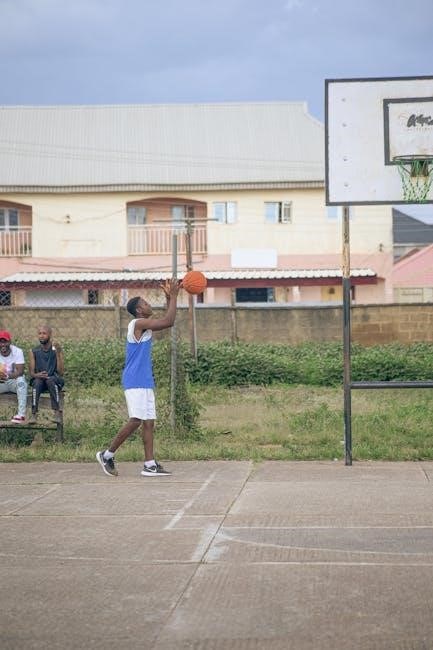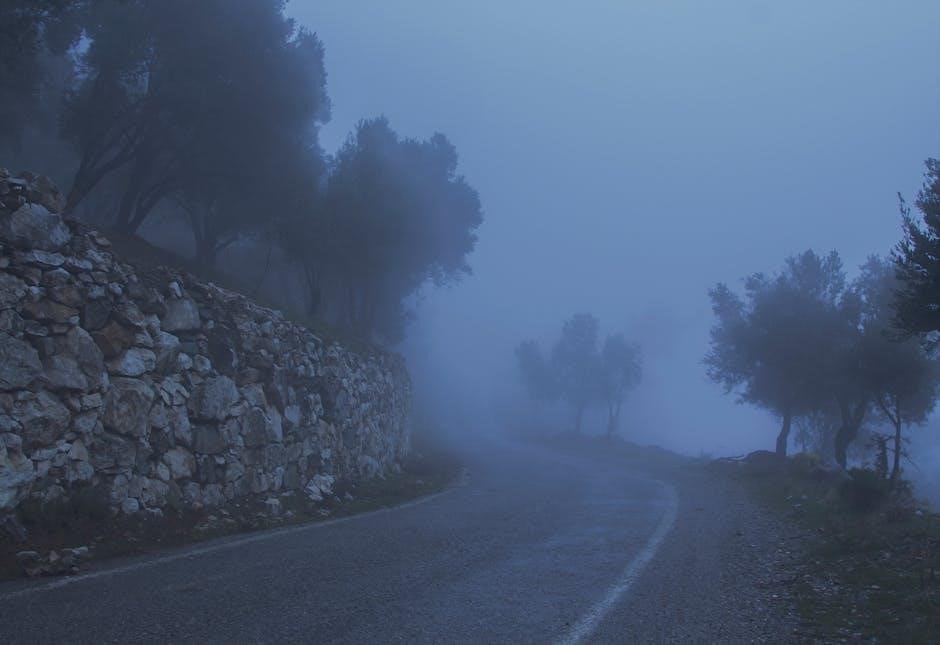Starting with this 6th edition, learners gain a solid foundation in programming concepts, utilizing a clear, step-by-step approach with a January 6, 2022 publication date.
Pearson’s text, ISBN-13: 978-0137601868, prepares students for success, offering accessible online resources and practical exercises for continued growth.
What is Programming Logic and Design?
Programming logic and design is the foundational process of planning and organizing a program’s steps before actually writing the code. It’s about thinking like a computer, breaking down problems into manageable, sequential instructions.
This 6th edition emphasizes building these crucial problem-solving skills, focusing on algorithms – the core of any program. It’s not about a specific programming language initially, but rather the universal principles applicable across various languages.
Understanding this logic allows you to effectively communicate instructions to a computer, ensuring the desired outcome. It’s the blueprint for successful software development, and a key component of the Pearson text.
Why Use the 6th Edition?
The 6th edition of “Programming Logic and Design” offers a thoroughly updated and refined learning experience, published January 6, 2022 (ISBN-13: 978-0137601868). It incorporates current industry best practices and addresses evolving technological landscapes.
This edition provides enhanced clarity, more relevant examples, and improved pedagogical features to facilitate deeper understanding. Students benefit from accessible online tutorials and a wealth of practice exercises.
It’s designed to equip learners with the essential skills needed to succeed in today’s dynamic programming environment, building a strong foundation for future studies.

Fundamentals of Programming Logic
Starting with core concepts, this text builds a strong base in problem-solving, utilizing algorithms and design principles for effective programming solutions.
Understanding Algorithms
Starting to grasp programming necessitates understanding algorithms – the precise, step-by-step instructions that computers follow to solve problems. These aren’t code themselves, but the logical blueprints before coding begins.
Think of a recipe: each instruction, from gathering ingredients to baking time, is a step in the algorithm.
Effective algorithms are clear, concise, and produce the desired outcome reliably.
The 6th edition emphasizes developing algorithmic thinking, crucial for translating real-world challenges into computational solutions, laying the groundwork for successful program design and implementation.
Flowcharts: Visualizing Logic
Starting with visual representations is key to mastering programming logic, and flowcharts provide exactly that. These diagrams use standardized symbols to illustrate the sequence of steps within an algorithm.
Rectangles represent processes, diamonds denote decisions, and arrows show the flow of control.
The 6th edition leverages flowcharts to help learners translate abstract ideas into concrete, visual plans.
This visual approach simplifies complex logic, making it easier to identify potential errors and refine the algorithmic design before committing to code, fostering clarity and efficiency.
Pseudocode: A Bridge to Code
Starting the transition from logic to actual code can be daunting, and pseudocode serves as an invaluable intermediary step. It’s an informal, English-like description of an algorithm, stripping away the strict syntax of programming languages.
The 6th edition emphasizes pseudocode’s role in planning and refining solutions before implementation.
This approach allows learners to focus on the core logic without getting bogged down in coding details, fostering a deeper understanding of algorithmic thinking and problem-solving skills.
Pseudocode builds confidence and prepares students for successful coding.

Data Types and Variables
Starting with fundamental concepts, the 6th edition details essential data types—integer, float, and string—and guides learners through declaring and initializing variables effectively.
Common Data Types (Integer, Float, String)
Starting your programming journey requires understanding core data types. The 6th edition meticulously explains integers, representing whole numbers without decimals, ideal for counting. Floats, conversely, handle numbers with decimal points, crucial for precise measurements. Strings are sequences of characters, enabling the representation of text and labels.
These types dictate how data is stored and manipulated; Mastering them is foundational, as different operations are suited for each. The text provides clear examples, ensuring a solid grasp of these essential building blocks for effective program design and execution.
Declaring and Initializing Variables
Starting to code involves declaring variables – naming storage locations in memory. The 6th edition emphasizes this crucial step, demonstrating how to specify a variable’s data type (integer, float, string) before use. Initialization assigns an initial value, preventing unexpected behavior.
Proper declaration and initialization are vital for organized and predictable code. The text provides practical examples, illustrating best practices for variable naming and assignment, ensuring a strong foundation for building robust and error-free programs.
Variable Naming Conventions
Starting with clear variable names is paramount in the 6th edition. The text stresses readability and maintainability, advocating for descriptive names that reflect a variable’s purpose. Avoid spaces and special characters; use camelCase or underscores for multi-word names.
Consistent conventions enhance code comprehension. The book details common practices, emphasizing the importance of avoiding reserved keywords and starting names with letters. Following these guidelines fosters collaborative coding and reduces potential errors, leading to cleaner, more understandable programs.

Control Structures
The 6th edition expertly introduces sequence, selection, and iteration—fundamental control structures—enabling programmers to dictate program flow and build logical solutions.
It details If-Then-Else and Switch statements for decision-making, forming the basis of dynamic program behavior.
Sequence, Selection, and Iteration
These three core control structures are foundational to programming logic, as detailed in the 6th edition of this text. Sequence involves executing instructions in a linear order, one after another, mirroring how tasks are often performed.
Selection, utilizing structures like If-Then-Else, allows programs to make decisions based on conditions, choosing different paths of execution. Finally, iteration—encompassing loops—enables repetitive tasks to be performed efficiently, reducing code redundancy.
Mastering these structures, presented with clarity in Pearson’s publication (ISBN-13: 978-0137601868), is crucial for building robust and dynamic applications.
If-Then-Else Statements
If-Then-Else statements are fundamental selection structures, enabling programs to execute different code blocks based on whether a condition is true or false, as explained in the 6th edition. The “If” part checks the condition; if true, the “Then” block executes.
If the condition is false, the optional “Else” block provides an alternative path. This control flow is vital for creating responsive and adaptable programs. Pearson’s text (ISBN-13: 978-0137601868) provides clear examples and exercises to solidify understanding of this crucial concept.
Switch Statements
Switch statements offer a concise alternative to multiple If-Then-Else statements when evaluating a single expression against several possible values, detailed within the 6th edition. They improve code readability and efficiency by directly jumping to the matching case.
Each case represents a specific value, and the corresponding code block executes if a match is found. Pearson’s resource (ISBN-13: 978-0137601868) illustrates practical applications, ensuring learners grasp this powerful control structure for streamlined decision-making in their programs.

Looping Structures
The 6th edition details For, While, and Do-While loops, enabling repetitive task execution; Pearson’s ISBN 978-0137601868 guides implementation.
For Loops
For loops, as detailed in the 6th edition (Pearson, ISBN-13: 978-0137601868), provide a structured way to repeat a block of code a predetermined number of times.
They excel when the number of iterations is known in advance, utilizing initialization, condition, and increment/decrement statements; This control structure streamlines repetitive tasks, enhancing code efficiency and readability. Mastering For loops is crucial for building robust and scalable applications, as highlighted throughout the text’s practical examples and exercises.
The book offers clear guidance on implementing and utilizing For loops effectively.
While Loops
The 6th edition of “Programming Logic and Design” (Pearson, ISBN-13: 978-0137601868) explains While loops as control structures that repeatedly execute a block of code as long as a specified condition remains true.
Unlike For loops, the number of iterations isn’t necessarily known beforehand. Careful consideration must be given to ensure the condition eventually becomes false, preventing infinite loops. The text provides practical examples and debugging techniques to master While loops, essential for dynamic and responsive program behavior.
This loop type is vital for various programming scenarios.
Do-While Loops
The “Programming Logic and Design” 6th edition (Pearson, ISBN-13: 978-0137601868) details Do-While loops as a variation of the While loop, guaranteeing the code block executes at least once before checking the condition.
This is crucial when you need to perform an action regardless of the initial condition. The loop continues iterating as long as the specified condition evaluates to true. The text emphasizes the importance of condition management to avoid infinite loops, offering debugging strategies.
It’s a powerful tool for interactive programs.

Functions and Modular Design
The 6th edition (Pearson, ISBN-13: 978-0137601868) explains how functions promote code reusability and organization, simplifying complex programs through modularity.
Defining and Calling Functions
Starting Out with Programming Logic & Design, 6th Edition (Pearson, ISBN-13: 978-0137601868) meticulously details function creation, emphasizing the importance of a function header and body.
Functions are defined with a clear purpose, accepting arguments (inputs) and potentially returning a value (output). The text illustrates how to call these functions within a program, passing the necessary arguments to execute the defined logic.
This process promotes code reusability and modularity, crucial for building larger, more manageable applications. Understanding these concepts is fundamental to effective program design.
Passing Arguments to Functions
Starting Out with Programming Logic & Design, 6th Edition (Pearson, ISBN-13: 978-0137601868) thoroughly explains how functions receive data through arguments.
Arguments act as inputs, allowing functions to operate on different values each time they are called. The text details passing arguments by value – where a copy of the data is sent – and by reference, enabling modification of the original variable.
Proper argument handling is vital for creating flexible and reusable functions, enhancing program efficiency and clarity.
Return Values from Functions
Starting Out with Programming Logic & Design, 6th Edition (Pearson, ISBN-13: 978-0137601868) comprehensively covers how functions provide results back to the calling code using return values.
Functions can return a single value of a specified data type, allowing them to perform calculations or operations and deliver the outcome. The book emphasizes the importance of defining a return type for each function.
Understanding return values is crucial for utilizing function results effectively in larger programs, promoting modularity and code reuse.

Arrays and Collections
Starting Out with Programming Logic & Design, 6th Edition (Pearson, ISBN-13: 978-0137601868) details one and two-dimensional arrays, and manipulation techniques.
One-Dimensional Arrays
Starting Out with Programming Logic & Design, 6th Edition, expertly published by Pearson (ISBN-13: 978-0137601868), introduces one-dimensional arrays as structured collections of data elements, all of the same data type.
These arrays are accessed using numerical indexes, beginning with zero, allowing for efficient storage and retrieval of multiple values under a single variable name. The text thoroughly explains how to declare, initialize, and access elements within these arrays, providing practical examples to solidify understanding.
Students learn to iterate through arrays using loops, performing operations on each element, and ultimately mastering this fundamental data structure.
Two-Dimensional Arrays
Starting Out with Programming Logic & Design, 6th Edition (Pearson, ISBN-13: 978-0137601868), expands upon one-dimensional arrays by introducing two-dimensional arrays – essentially arrays of arrays.
These structures are ideal for representing tabular data, like spreadsheets or game boards, utilizing rows and columns for organization. The textbook meticulously guides learners through declaring, initializing, and accessing elements within these arrays, employing nested loops for efficient traversal.
Students gain proficiency in manipulating two-dimensional arrays, building a strong foundation for more complex data structures.
Array Manipulation Techniques
Starting Out with Programming Logic & Design, 6th Edition (Pearson, ISBN-13: 978-0137601868) delves into essential array manipulation techniques, building upon foundational concepts.
The text comprehensively covers searching algorithms – like linear and binary search – to locate specific elements within arrays. Sorting algorithms, including bubble sort and selection sort, are explained to arrange array elements in a desired order.
Students learn to efficiently modify array contents, insert new elements, and delete existing ones, enhancing their problem-solving abilities.

File Input/Output
Starting Out with Programming Logic & Design, 6th Edition (Pearson, ISBN-13: 978-0137601868) teaches file handling, covering opening, reading, and writing data effectively.
Opening and Closing Files
Starting Out with Programming Logic & Design, 6th Edition, details the crucial process of file management within programs. Properly opening a file establishes a connection, allowing data access, while closing it releases resources and ensures data integrity.
The Pearson textbook (ISBN-13: 978-0137601868) emphasizes the importance of these steps, demonstrating how to utilize appropriate functions to initiate and terminate file access. Failing to close files can lead to data loss or corruption, highlighting the necessity of diligent programming practices as taught in this edition.
Reading Data from Files
Starting Out with Programming Logic & Design, 6th Edition, comprehensively covers techniques for extracting information from files. The Pearson text (ISBN-13: 978-0137601868), published January 6, 2022, illustrates how to use input functions to sequentially access data stored within a file.
This edition emphasizes error handling during the reading process, ensuring programs gracefully manage potential issues like file not found errors. Mastering these skills, as detailed in the book, is fundamental for building robust and reliable applications.
Writing Data to Files
Starting Out with Programming Logic & Design, 6th Edition, details methods for storing program output into files. The January 6, 2022 Pearson publication (ISBN-13: 978-0137601868) explains how to utilize output functions to write data, creating or appending to existing files.
The text emphasizes proper file handling, including ensuring files are correctly closed after writing, preventing data loss. This edition provides practical examples, building a strong foundation for data persistence and management within programs.

Error Handling and Debugging
Starting Out with Programming Logic & Design (6th Ed.), published January 6, 2022, equips learners with techniques to identify and resolve common programming errors effectively.
Common Programming Errors
Starting Out with Programming Logic & Design (6th Edition), a Pearson publication from January 6, 2022 (ISBN-13: 978-0137601868), addresses frequent errors beginners encounter. These include syntax errors – violations of the programming language’s grammar – and runtime errors, occurring during program execution.
Logic errors, though not causing crashes, produce incorrect results. Off-by-one errors, infinite loops, and uninitialized variables are also common pitfalls. Understanding these errors, alongside effective debugging techniques, is crucial for building robust and reliable programs, as emphasized throughout the text’s accessible approach.
Debugging Techniques
Starting Out with Programming Logic & Design (6th Edition), published by Pearson (ISBN-13: 978-0137601868, January 6, 2022), highlights systematic debugging. This involves carefully reviewing code, using print statements to trace variable values, and employing a debugger to step through code execution.
Techniques include isolating the error, simplifying the problem, and utilizing breakpoints. Understanding error messages is vital. The text emphasizes a methodical approach, encouraging learners to reproduce the error consistently before attempting a fix, fostering robust problem-solving skills.
Exception Handling
Starting Out with Programming Logic & Design (6th Edition), a Pearson publication (ISBN-13: 978-0137601868, released January 6, 2022), introduces exception handling as a crucial error management technique. It explains how to anticipate and gracefully respond to runtime errors, preventing program crashes.
The text likely covers ‘try-catch’ blocks, allowing code to attempt an operation and handle potential exceptions. Proper exception handling enhances program robustness and user experience, ensuring stability even when unexpected issues arise during execution.
Starting Out with Programming Logic & Design (6th Edition), published by Pearson (ISBN-13: 978-0137601868), introduces core OOP principles like classes, objects, encapsulation, and inheritance.
Classes and Objects
Classes serve as blueprints for creating objects, defining their attributes and behaviors within the Starting Out with Programming Logic & Design (6th Edition) framework. Think of a class as a cookie cutter and objects as the cookies themselves – each cookie shares the same shape (attributes) but can have unique decorations (values).
This Pearson text (ISBN-13: 978-0137601868) explains how to define classes with data members representing characteristics and member functions dictating actions. Objects, instances of these classes, allow programmers to model real-world entities, fostering modularity and reusability in code. Understanding this distinction is fundamental to object-oriented programming.
Encapsulation and Inheritance
Encapsulation, a core OOP principle in Starting Out with Programming Logic & Design (6th Edition), bundles data and methods that operate on that data within a class, protecting it from direct external access. This promotes data integrity and modularity.
Inheritance allows new classes (derived classes) to acquire properties and behaviors from existing classes (base classes), fostering code reuse and establishing hierarchical relationships. Pearson’s ISBN-13: 978-0137601868 text illustrates how inheritance minimizes redundancy and enhances program organization, building upon established functionalities.
Polymorphism
Polymorphism, meaning “many forms,” is a powerful object-oriented programming concept explored in Starting Out with Programming Logic & Design (6th Edition). It enables objects of different classes to respond to the same method call in their own specific ways, promoting flexibility and extensibility.
Pearson’s publication (ISBN-13: 978-0137601868, published January 6, 2022) demonstrates how polymorphism simplifies code by allowing developers to write generic methods that work with various object types, enhancing code reusability and maintainability.

Resources and Further Learning
Enhance your learning journey with online tutorials, practice exercises, and projects complementing Starting Out with Programming Logic & Design (6th Edition), published by Pearson.
Online Tutorials and Courses
Numerous online platforms offer supplementary materials for Starting Out with Programming Logic & Design (6th Edition). Explore Pearson’s MyLab Programming, providing interactive exercises and automated grading to reinforce concepts.
Websites like Coursera and Udemy frequently host courses aligned with the textbook’s content, often taught by experienced instructors. YouTube channels dedicated to programming tutorials can also be invaluable, offering visual explanations of complex topics.
Remember to search specifically for resources referencing the 6th edition to ensure content alignment and avoid outdated information. Consistent practice alongside these resources is key to mastering programming logic.
Practice Exercises and Projects
Solidifying your understanding of Starting Out with Programming Logic & Design (6th Edition) requires consistent practice. The textbook itself includes end-of-chapter exercises, ranging from simple coding tasks to more complex problem-solving scenarios.
Seek out additional projects online – platforms like GitHub showcase beginner-friendly coding challenges. Consider building small applications, like a basic calculator or a text-based game, to apply learned concepts.
Don’t hesitate to experiment and modify existing code; this fosters creativity and deeper comprehension. Remember, hands-on experience is paramount to becoming proficient.
The Importance of Continued Practice
Mastering programming logic, especially when starting with Starting Out with Programming Logic & Design (6th Edition), isn’t a one-time event. Consistent practice is absolutely crucial for long-term retention and skill development.
Regularly revisiting concepts and tackling new challenges reinforces your understanding. Don’t be discouraged by errors; debugging is a vital part of the learning process.
The more you code, the more intuitive it becomes. Explore online resources, participate in coding communities, and build personal projects to maintain momentum and expand your abilities.






































































